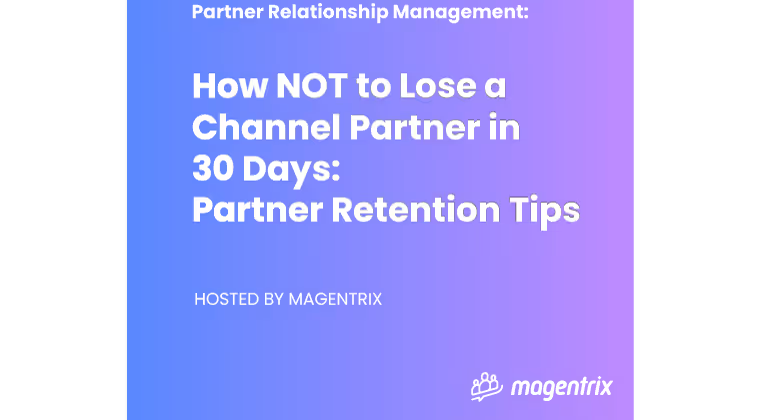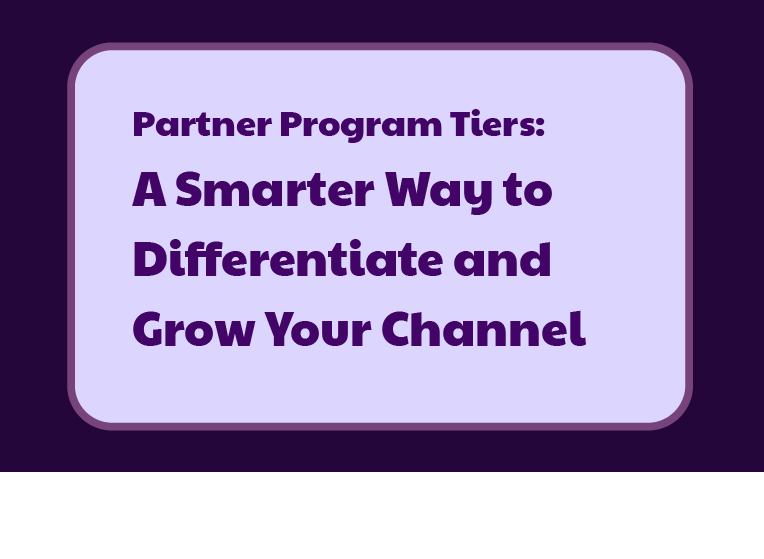- Introduction
- Why the first 30 days in channel partnerships are crucial
- How to lose a channel partner in 30 days
- The culture shift affecting SaaS partnerships
- Partner Retention Strategy 1: Don’t lose the personal relationship
- Partner Retention Strategy 2: Get on the same page from the beginning
- Partner Retention Strategy 3: Provide adequate enablement
- Partner Retention Strategy 4: Provide swift support
- Partner Retention Strategy 5: Be transparent about deal registration
- Partner Retention Strategy 6: Give partners reasons to trust you
- Adam Alfi's Background as a channel partner
- About EV Software and Business Solutions
How Not to Lose a Channel Partner in 30 Days: Partner Retention Tips
This guest is a channel partner with a horror story showing vendors how NOT to lose a partner in 30 days. Get his 6 partner retention tips.

Table of Contents 📋
November 21, 2022
The Ultimate Channel Sales PodcastTable of Contents 📋
Listen to the podcast with guest speaker: Adam Alfi of EV Software and Business Solutions. Aired on October 25, 2022.
“Fail hard. Fail fast. Fail often,” isn’t a quote we like to associate with partnerships.
But some partnerships fail incredibly fast.
Some in as few as 30 days.
Forrester reported:
If a new partner fails to market and sell your offering within the first 90 days of recruitment, they likely never will.
What you do in the early days of a partnership sets the tone for the rest of the relationship – particularly, what you do in the first 30 days.
At the start of the partnership, it’s important to be careful and leave first impressions that can help create partners who are:
- Confident in your brand
- Come forward for support
- And want to promote your product
The attention you pay to partners during this critical timeframe can result in either:
- A positive outlook for a long-term partnership
- Or, cause your partners to lose interest altogether
Today, we welcome a special guest to help improve your partner retention rates. He’s a channel partner with a horror story that shows you what not to do and shares tips for vendors on how they can retain their channel partners.
Continue reading to:
- Set a standard for retaining channel partners for the long-term
- Discover what aspects of your partner program help or hinder your partners
- And find out what truly motivates partners to sell
Our guest is a multipreneur with over 25 years of experience in IT, with a career spanning various roles, including project management, consulting, and even a stint on Wall Street.
Today, he runs a managed service provider (MSP) – EV Software and Business Solutions, which serves startups and enterprise clients.
He's with us to talk about how not to lose a channel partner in 30 days, specifically partner retention tips.
Paul Bird: Why do you think the first 30 days are critical when starting a new partnership with a vendor?
Adam Alfi: It's like any relationship. It's about building trust. It doesn't matter which end of the channel you're on. You have to understand a couple of things:
- Both sides are going to make money – they're going to have to. And if they don't, it's never going to work.
- Greed loses channel partners. As soon as you want more than you're willing to give the partnership breaks down. Partners can smell greed in the first 30 days; you could probably sniff it the first couple of days.

Paul Bird: When we first met, you mentioned that you had a partner experience that was a textbook example of how to lose a partner in 30 days.
Can you take us through that experience?
Adam Alfi: Man. Since the last time we spoke, it's now two examples. We were going to resell licenses through one of them. Very quickly, we were negotiating the contract before the relationship had started.
Within 30 days, they tapped the customer to see if they could sell the licenses themselves.
Paul Bird: Oh, my.
Adam Alfi: Before we even sign the paperwork, I can see where this relationship is going. There was no trust. We ended up going with another distributor instead.
On the aspect of the first 30 days, when we went to their competitor and explained the situation, we got the complete opposite service and onboarding experience.
Everything was done so right, we've been using them for the past 5 or 6 years and have never looked back.
Paul Bird: Oh. That's great.
Now, you said you had a second example, so something has come up in the last few weeks since we've been talking.
Adam Alfi: So it has. And that relationship has ended. It was also with a major software provider.
Again, we were happy with them at the beginning. And when I say the beginning, I mean the first couple weeks. That is, until we started working on the first deal...
Then they started independently contacting the customer and negotiating on licenses without us.
Paul Bird: Oh, no. They're jumping at a turn, almost.
Do you think these are just overzealous salespeople that don't respect the channel, or do you think it’s something else?
Adam Alfi: I think it's a couple of things. There's a bit of a culture change from the SaaS situation in general.
At first, you rely on partners, but then you get big enough that you don't need channel partners anymore. And suddenly, there's no hunger.
Partnerships and the channels, as you and I would know it, is 110% mutual respect on:
- You have this
- I have this
“There are clear lines of delineation on when I wear your hat and when I wear mine.”
That's what helped us all grow. And now those lines are starting to blur for a number of reasons.
We are:
- A Microsoft Gold Partner
- With around 200 Microsoft clients
- Covering 4 continents
Microsoft understood that the market was big enough. They understood there was no way they could reach the small-to-medium businesses alone. It was a huge market, untapped by enterprise.

When you and I got our first jobs, if you worked for a company with Microsoft Office on their computer – you knew that company had money.
Now, as a five-person startup for less than $100 a month, you can have a complete OfficeSuite that rivals enterprise with cloud and everything.
But even with that aspect, it happened because of the partners. Those are your local resellers in touch with that small-to-medium business market hungry for the technology. That was the driver of why Microsoft ended up eating a large part of the market share.
Then you start getting greedy and thinking, why do we have channel partners? And why do we have resellers?
That’s where you start losing sight of what got you there (your channel partners). Eventually, you get labeled out of the market. It's happening a lot these days.
Paul Bird: And you don't have relationships, right?
You can be the biggest company in the world, but if you can't have partner relationships that are at a regional and local level, it's not scalable.
Adam Alfi: A hundred percent.
I was just looking at car insurance. We had to change something. The biggest hassle was, “God, I have to call the insurance company.”
- I don't have a dedicated rep
- I'm going to have to go into the queue
- They don't know what the situation is
You lose sight of the personal relationship. That relationship is more beneficial than the product will ever be because it’s with a trusted consultant. When you take them out, the relationship with the company breaks down.
Paul Bird: For sure.
Here's a question for you: Some vendors look great on paper, but that's where it all ends.
From your perspective, as a managed service provider, what are some things that makes a vendor look like a good partner? And then what motivates you to actually get involved and sign the partnership agreement to start promoting them?
It takes critical thought when it comes to looking at the company, and the industry they serve, but then you're the one taking the step and investing in their business.
So what are some of the things that you look for? What's your process of vendor vetting?
Adam Alfi: Where are they now and how did they get there?
If you're a startup and you're really pushing, I'm more inclined to help. I know you'll go out of your way to keep me as a client. I'm not too big for you. I'm never going to be too big for you. You're always going to care about my business. I look into that.
The other piece is just like any consumer or any customer: I don't want to be sold; I want to buy.
I want you to tell me what you have, so I say: I want to buy this from you.
I don't want to be sold an extra package. I don't want to be sold anything, as a matter of fact.
If you give me your spiel and I don't like it and we move on, you have to understand I've moved on. If you want to build a relationship, build a relationship. Don't keep on trying to sell to me.
And that's critical for me in picking a vendor.
Paul Bird: Let's think about it from a vendor perspective. What are some of the things you think people can do when they start a relationship? What can the vendor and partner do to get on the same page from the beginning?
Do you have any suggestions for vendors to get it right from the start?
Be transparent

Adam Alfi: Be transparent on whatever the process is going to be from both sides.
If you have a service or a product that I'm reselling to my customer, I've vetted your product, and I believe it's the best.
I need to be transparent with you from the beginning, so you understand the deal I'm bringing to the table. You need to be transparent with me on delivery.
Anything that you tell me, I'm going to trust until I can't anymore.
Trust is going to break down the relationship quicker than anything.
“Only errors are magnified. When things are going well you don't hear a peep. But all you need is that one amplified mistake to ruin a relationship.”
Trust is hard to gain back.
Being transparent from the beginning avoids all complications. At some point, if I understand it's a channel mistake and we say we're sorry, we're good.
Trust is 100%. Trust has to be there unequivocally from both sides.
Paul Bird: You've got to start with the trust and the transparency. 100%.
As I read through Forrester reports, they talk about is onboarding. They say if you don't have a partner engaged and selling your product within the first 30 days, they'll never flourish.
I understand that partner onboarding is an ongoing process. Do you think it's realistic to expect you'll achieve results within 30 days?
Build real relationships
Adam Alfi: You probably will achieve about 75% of relationship building in the first 30 days. It's the base you set for the entire relationship.
It's all about user experience. I need proper training in whatever process you involve me in.
If I run into any issues, who am I reaching to? All that stuff is trust-building, and it's change.
You're going through change; you're putting people through change. Change shakes things up. Everybody, at that point, is looking for safety.
“As soon as you can blanket [partners] with everything they need to feel safe in the first 30 days, you have that relationship on solid ground.”
Cut your losses
Adam Alfi: If you mess up relationship building, you're done. If an endpoint on the client side doesn’t like you in the first 30 days, there is nothing you can do to change a negative relationship. It's done.
You as the vendor need to be on your best behavior and give that best service. It's the baseline expectation. That will make it or break it.
Paul Bird: In some cases, the definition of success is different from a partner's perspective as opposed to the vendor's.
Any thoughts, best practices or recommendations you could share so that both sides align on a shared vision of success?
Know what side of the partnership you’re on
Adam Alfi: It boils down to what's more important to you:
- Doing the work
- Or, relationship building with the client
You can't have both.
If you're going to enter into a strategic partnership, there is going to be one side of the partnership that:
- Owns that relationship
- Or, provides the service that's lacking
That's why you are hired, to fill that gap. You just have to accept which side you're on.
That is also the line that cannot be crossed. As soon as it's crossed – the partnership is over. In fact, it's over for all relationships.
“If I cross a line and lose a client, you don’t get to keep the relationship with the client. Now the client trusts, neither you nor I.”
Knowing where you stand in that relationship is key.
Paul Bird: Losing it for both is a lose-lose situation. Nobody comes out on top.
Adam Alfi: Exactly. And it goes back to something we mentioned earlier: greed.
Don't get greedy and the relationship.
This pie is big enough for all of us. Everybody's going to get a piece. As soon as you start looking at my pie, we both start looking bad.
Paul Bird: Going through that onboarding process, understanding the vendor solution is critical.
What's the best way for somebody to educate you and your team to make sure the solution you're offering is the best fit for your customers?

Adam Alfi: If you want to boil it down into a basic example, it comes down to the discovery.
Study your client.
Speaking to the decision maker is one thing and they'll give you one story. But actually doing discovery and talking to your end-users about the service or product enlightens you on many other things.
For example: accessibility. Sometimes management doesn't understand all the accessibility issues, requirements or needs, the team or the end-user has.
Doing proper discovery enlightens you on these aspects.
Understanding the business vision is impactful because it's going to give you a solution that mirrors their process.
You can't recommend a solution to a client without understanding the end goal. Otherwise, you're not building on the foundation they're growing on. The client has to be transparent with you there.
- Why are you bringing on the system?
- What is your end goal as a business?
- What are you trying to achieve?
These questions are the difference between picking two different ERP systems.
One of them may be heavy on manufacturing because that's your heavy processing, not the end-point of the supply chain. Or, it could be an e-comm process, and that solution is completely different; we have to architect it entirely differently.
I'm exacerbating a point to make a point by using manufacturing or retail as examples. But if you want to look at it from a corporate America perspective, you can boil it down to a PMO.
A PMO’s job is to manage the projects in the portfolio in a program; making sure that things adhere to a certain process.
As soon as you over-involve yourself as a PMO, you are going against the purpose of said PMO.
When I’m brought in to look at a PMO process, my main goal is to ask: Are you doing this because you're getting audited and there are issues?
Or, are you doing this because there seems to be a lot of slip in your delivery? Now we need to take a look at the scope.
How are you scoping these projects from the beginning versus what the result is?
Even from that smaller level, where we're looking at departmental processes within a company, it’s discovery, discovery, discovery.
How to do discovery right
Paul Bird: Do you think a lot of software, hardware, and service vendors lack discovery as part of their onboarding or enablement process?
Adam Alfi: There are a lot of people that think they do discovery right. I won't claim to be an expert, because it's an ongoing learning process.
People will claim that they do onboarding, but they really don't. At the end of the day, your helpdesk will suffer. And you have to understand, from a transition perspective, it's an indicator– how’s your helpdesk looking?
“People neglect to understand what good discovery is – it’s ongoing. Discovery is one of these things where it requires a lot of documentation, so nobody wants to do it. No client ever wants to pay for it because they really don't understand the value of it. That is, until they launch a process or a program without doing discovery.”
Then they understand how valuable discovery was.
I think there's an underestimation. There's a little bit of a delusion of grandeur where they think they've onboarded, but really you've left the end-user in the dark.
How do you make discovery successful?
I'm sure there are some metrics everybody's trying to track, but at the end of the day, it's really just trying to do the best you can.
We have people that we onboard for our clients as part of our MSP Service. I promise you that it's a continuous improvement process.
As soon as you think you got it right, you've missed a step.
Every single onboarding process three years ago was a lot different than it was a year and a half ago, and is a lot different than it is today.
And we're just talking about in a three or three-and-a-half-year-year span.
You always have to keep yourself on your toes.
Paul Bird: It's been a wild three years.
What about training as part of this? Are you a fan of one-to-one training or self-guided partner training? Where do you think training plays in with the whole onboarding process? Not only from a vendor's perspective but from a customer’s.
Adam Alfi: There has to be a commitment on the client side as to what the plan is.
Let me just backtrack half a second by saying,
“Training is not just part of the onboarding process. Training IS the onboarding process. By the end of the training, they should know everything they need to know before going out in the wild.”
That's from an end-user perspective and a customer perspective.
If I’m the midpoint of selling you Microsoft Office 365 licenses for your company, it's my responsibility to make sure you know how to use that tool. Not Microsoft's.
As part of my onboarding process for an organization to the tool, there has to be training.
From there, you start looking at different training strategies.
3 different training strategies partners love

1. Train the trainer
There is the very famous Train the Trainer method, where you gather the top minds in the company. Then people start coming into your company and training the masses.
2. One-to-one partner training
Then there is one-to-one training, where you train a channel partner face-to-face or virtually.
3. Standard partner training
And then there is regular training, which is like your lunch and learns. Or, you go to a classroom or conference room setting, and you’ll sit down for training.
What style of training works best to retain channel partners?
Adam Alfi: They all have their benefits. I think that it depends on company size. Logistics definitely end up playing a role. If you're a company of 10 people, we could probably get in-person training done in a day or two.
If you are in the 50-100 size, Train the Trainer works.
Anything above that, you really have to come up with more of a university strategy, where it's classes at a certain time. You're going to have to give them remote and on-site training.
There's a bigger strategy needed behind that because it's a bigger deployment.
“In my experience, there is nothing better than the one-on-ones or the one-on-fives. Mainly because it's your best opportunity to get some hands-on experience in training.”
Then you have a lot of opportunity to bring up some actual use-case scenarios of your day-to-day job, rather than just trying to blanket all the features on the system.
Blanketing all of the system features is a big aspect of training a lot of trainers don't realize they're doing. Curriculums aren't really surrounded by enough day-to-day use-case scenarios.
I'm going to end up going to training where vendors are explaining a lot of stuff that has nothing to do with the job I’m doing. And they’re really wasting their company time and resources.
Understanding departmental training is useful to what these people are doing day-to-day. That gets you more use out of whatever service and whatever tool you're reselling.
Paul Bird: So again, you're back to relationships. With one-on-one training, or one-in-five training, there's dialog. You're able to build relationships.
Online training requires discipline
Paul Bird: When I did my VMware Technical Sales certification, I did it all online. What's your opinion from an online training or self-guided training perspective? Do you think it's useful?
Adam Alfi: I think it's very useful. But I also like having accessibility to another human on the other side for clarification.
In the last three years, I think it's proven that not only can it be done, but the scale of how it can be done, is enormous.
Take, for example, university enrollments. Online classes and degrees, even from known, reputable universities, have been made available and accessible, globally. Just look at the enrollment rates. These universities made money from students that have never stepped foot on campus.
It's enormous, and the opportunity becomes enormous.
Going back to the access point, you could train me on your product right now, and I could start selling for you right now. If we choose never to meet face-to-face, great. But we still choose to have a relationship.
If I'm selling for you, I'm studying your training, etc. I'm a huge proponent of online training.
Self-guided training is really what separates men from the boys. I say this because it brings out the biggest part of what's going to make you a successful business or partner relationship – discipline.
You are on your own. Yes, it's a partnership, but it's a mutual partnership for you to expect an outcome. You have to put in some effort like myself. That's where it gets hard.
Anybody that tells me that an online degree is easier to get, I challenge you!
It's easy for me to stop a class dead in its tracks, ask a question, get an answer, and move on. Rather than read it, try to interpret it, try to research it, and reach for help. That's a lot of work on your own.
Those are great characteristics to have, to be able to:
- Navigate
- Research
- And be scrappy to get answers
That also translates to success: You're on your own.
If you add a partner relationship to it and the other side also puts in that much effort, it enhances the situation for both of us.
Paul Bird: There we go. That's more of a win-win.
What enablement materials do partners need to succeed?
Paul Bird: Thinking about it from a vendor's perspective, a lot of them provide sales and marketing content, things that are there to enable you the as the partner.
What type of resources do you want them to provide? I'm sure that you have no interest in 150-page white papers. What type of content should they give you to help enable you to sell their product?
Adam Alfi: I would say, for the most part, what the big boys are doing from the content production standpoint.
We work with Microsoft, but we also work with SoftwareONE as a vendor for software.
“Documentation is nice, not a white paper, but brochures. Marketing content.”
Small-to-medium-sized businesses have become creative in that aspect. They're using social media to their advantage, which is fantastic.
That's a little bit of a shift in the paradigm from a support perspective.
No longer is the support going to be, how do I get the product marketed? Now it's going to be:
- How do I continue to stay engaged with the product?
- How do I keep that person engaged?
- What support do I need to give beyond that?

Adam Alfi: How many times have you dialed a 1-800 number to get support and the first thing you do is just dial a couple of zeros to see if you get a human?
Paul Bird: Every single time.
Adam Alfi: Exactly. That's the level of support that we really need to start shifting toward because on a vendor level, I'm looking for the same thing.
"Support from a vendor perspective is about fixing the problem I have now. I don't want to go into a queue. I don't want to get a ticket and have a number. I need instant gratification. I want to speak to somebody."
You have to understand if I'm reaching out to you as the vendor, I have a problem now. Not because I have a customer who has a ticket.
Last week, we were in Florida, and we went to a restaurant for breakfast. The service was slow because their POS was down. We got our food, ate, and asked for the check. And we waited, waited, and waited.
People are annoyed because they want to leave and nobody carries cash anymore.
If you're a POS provider, and I'm calling you saying I need help – you better have an insider on the other side of that channel to pick up the phone.
I cannot wait. I need instant gratification.
“[Instant gratification] is going to have to trickle down to service.”
I need a response immediately. Chatbots and auto-attendants have been great for that. Social media happens to be great, too. The interaction you get with brands on social media has been spectacular.
A couple of my competitors use social media to their advantage. They create private channels on social that give them direct access to their own customers. They can instantly chat, report feedback, and leave reviews that get promoted on social media.
That's the level of service happening now.
Whoever figures out where the trend is going after the social media bubble bursts will be the winner.
Paul Bird: Absolutely. It is so true.
I've got a problem, I've got a problem now. Not a four-hour SLA response time. My problem is right now. And if I don't get it fixed right now, I might start looking for another vendor.
Adam Alfi: As I said, all it takes is one bad experience. 80% of consumers will leave a brand they are loyal to from one bad experience.
Paul Bird: Here's another conversation you and I had a couple of weeks ago, about registering opportunities with vendors.
A lot of partners use partner portals or different relationship management tools and things like that. What's your take on sharing your prospects, or your client's contact information, through a deal registration process? Where do you sit on this?
Adam Alfi: Uneasy. Always.
It goes back to what we spoke about earlier on the podcast, trust. I have to trust you're not going to mess this up for the both of us.
As a small-to-medium-sized business, every single client counts. Every single one of them.
You are never too small for me ever. My job is to facilitate the proper environment to allow you to grow to get bigger.
You cannot look at any number as small. You have to stay hungry. If I give you that information:
- What are you doing with it?
- Are you really just registering the deal?
There are distributors we do that with. We have trust. I take good care of my distributors. I consider them friends. I've flown on international vacations with them. I've built solid relationships with them because there has to be that trust aspect.
As I said, it's uneasy when I give my client's information to somebody. But sometimes, it's necessary to do business. Sometimes the channel you are dealing with, or the product you're dealing with, is represented by people with honor.
They understand what the relationship is. They understand the information I gave them is gold.
The only reason why we should ever be talking about that information again is if you got this deal from somebody else that's trying to register it. And then you just want to call and get more information on who got the deal first.
“Beyond that, I am giving you my livelihood, because that's what a customer is: my livelihood. I'm uneasy about giving it to you, but I'm giving it to you because I trust you.”
Paul Bird: In the past, if I had one of my partners register or share an opportunity with me, and it came in through another channel, and is being registered twice, I’d call the first partner, and let them know that somebody else is fishing in their pond.
At the same time, if I'm getting an end-user contact directly. The first thing I asked them was: Who do you work with for hardware software services?
And when they say, I work with this company, I pick up the phone to return one of the sheep to the flock. That's the approach that I've always taken. But I'm not sure that happens all the time today.
Adam Alfi: That situation is rare. I hope people hear this and understand the agony of the reverse of what you just said. Because it always happens with the bigger fish.
Why are you trying to fish in my pond, man? Let's work together. This is how we build relationships.
This goes back to the first kind of story that I told you: How to lose a channel partner in 30 days
Even before we were negotiating something and someone's not my client yet, but I'm talking to you about it, you don't go and pick up the phone and think that that client is fair game. That's overstepping a line.
“I wish more vendors would ask, who in that area do I know that may enhance this relationship?”
Then I may end up getting more business on the backend of it from the partner that has a relationship with that end-client.
Even if the deal wasn't Paul’s, Paul probably deals with a couple of distributors. I'm not the only channel he's working with.
If I'm throwing Paul a bone every now and then, guess where Paul goes when he needs a product or service? Or they need some channel services and help? They're going to the person that keeps throwing Paul's bones. That’s how it works.
Paul Bird: And we're coming back to the foundation of where this started, which is trust and transparency. If you have it, nothing else matters. If you don't have it, nothing else matters.
Paul Bird: With the vendors I've talked to, one of the things I've seen a lot is trying to incentivize partners to share client information.
They offer gift cards, they offer SPIFFs, and they offer whatever they can. Do you think that is a rational or a good way for them to be able to spark some business?
Adam Alfi: It goes back to what's important. Is it:
- The deal?
- The job?
- Or is it the client?
You have to understand where you are in that relationship. Are you going to own the client or the deal?
Incentives and loyalty programs help. Telling me that incentives don't work would be naive. But it's also a dirty way of doing it. Because you're basically putting a price on a relationship that I either know will be worth more, or not worth more.
I don't know what the potential of it is.
Or, you're declaring that that relationship is worth whatever incentive you give me.
Loose lips sink ships. As soon as you give my client information to somebody else, you're giving them permission to contact them.
If you're going to buy software from SoftwareONE to resell it to a customer, SoftwareONE will end up knowing who the customer is.
I set the boundaries early. The boundaries are that this is my client, and you are the pass-through. There has to be trust.
I'll be very honest with you. The moment SoftwareONE turns around and calls my customer without telling me, is the last time I'll do business with them. At that point, my trust is lost.
Paul Bird: And all of these elements, when it comes to onboarding, trust building, relationships, going through enablement, training – these are all elements of a partner program that a vendor will put together.
What are some of the things that appeal to you when you start looking at different programs like Microsoft’s Partner Program? And what are some of the things that just turn you off, you're not going to entertain at all?
Adam Alfi: The ability to train staff is where most operational decisions get made. Business continuity is what I live and die for; it's how I make my living. It’s making sure that business continuity for clients continues at all times.
And, I look for vendors being able to give me the support I need through change.
Microsoft changes things every six months. But Microsoft is good at communicating changes.
On a support level, if things happen in the organization that ends up changing, i.e. how the support is supplied to an endpoint, these changes need to be communicated.
Some vendors are afraid to communicate change because they don't want to rock the boat. But trust me, boat rocking based on bad decisions is worse than boat rocking to fix a problem.
Early communication is key in terms of change.
I look for vendors willing to tell me what's behind the curtain. What’s coming up, so:
- I'm not surprised
- My client is not surprised
That's a big thing. If your client is surprised by a change you haven't communicated, both of you have lost the client. That client no longer trusts me to give them a service, advice, or product.
"If a client has a bad experience with Microsoft through me as the channel, they're going to say my experience with Microsoft has been horrible."
Sometimes it was because of a channel partner that really didn't do their job; that wasn't communicative enough. They weren’t kept abreast of change to be able to educate themselves on these changes.
You're going to get questions on changes from your end-user.
A vendor that has a robust training program and vast communications – that put out press releases on changes they have to their services – that's good communication. I’m not surprised.
Whatever is on the backside of the decision that's going to affect my end-user, I'm already prepared with the message and whatever training I need to provide. There's a cascading effect with good communication.
Paul Bird: So you've shared with us some just great sage advice.
Getting back to the topic today: How to lose a channel partner in 30 days – that's not a lot of time. From what you've said, time is of the essence in the partnership.
What do you think is the most important thing that a vendor has got to focus on to make sure you get to success in the first 30 days?
What do you think the number-one thing they need to focus on is?
Adam Alfi: They need to focus on making the customer feel like they are the only customer you have. If you could support your partners in giving that warm and fuzzy feeling to the client, the relationship between you and the vendor will grow.
That client is always going to be with that vendor. If you've made him look like a million bucks, they'll follow you forever.
- Be there for your client.
- Treat them like humans.
- Understand their pains.
Really, that's the key to success in any relationship.
Paul Bird: So if vendors follow the advice you've shared today, what kind of results do you think they can expect?
Adam Alfi: Expect nothing. I know it's a pessimistic thing to think, but I'm going to flip it around. I'm going to make it positive.
Expect nothing because you always have to be ready that you're going to have to do the work yourself.Then, that sets you up to be pleasantly surprised when the vendor does the job and you are 100% satisfied.
And if a vendor does make you look like a million bucks, trust me, there's a lot of work behind that. That isn’t easy, it isn’t free, and it wasn't effortless for them. There's a team of at least two or three people busting their butts, trying to make you look like a million bucks in that first 30 days.
If you both share a real vision, any words of appreciation go far.
My wife does this on a consistent basis. She buys $50 Starbucks gift cards. Every now and then, if somebody does a favor on her behalf, she drops that $50 gift card. That's built more relationships for her than anything else.
It’s something small, but it just makes the other person understand you know they put in effort.
Adam Alfi: It's really knowing that you're dealing with people. At the end of the day, your clients-clients are going to be:
- The end-user of the product that you're giving
- The service that you're getting
So being able to see a product from the other side and try to make it better and know that you can make it better is the reason I'm here now.
Just taking that approach where we are talking about human beings, not the technology itself.
Adam Alfi: EV Software and Business Solutions started as a web development shop. We were a small number. Then we started looking into channel sales and partnerships, which really took our business to the next level.
From there, we expanded into the managed services (MSP) business.
We create an offshore team for our clients. It's being able to provide an offshore service to anybody, anywhere in the world, at any time.
Connect with Adam Alfi on LinkedIn or on Twitter.
Connect with Paul Bird on LinkedIn, book a demo with him, or contact him via email paul.bird@magentrix.com.
FAQs about
No items found.



